So, you’ve been invited to a farbrengen and aren’t sure what to expect. Well, you’re in good company—neither do most people.
Here is what it is:
Farbrengen (fɑ:r-breɪng-ɪn) n. 1. Yiddish for “spending time together.” 2. an informal, inspirational chassidic gathering where words of Torah are shared and melodies are sung over refreshments and spirits. Also called hitvaadut or hisvaadus in Hebrew.
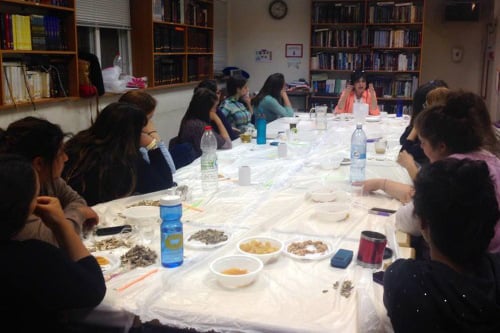
Why Was I Invited?
Farbrengens can be held to celebrate or commemorate all kinds of events. People often host them in honor of their birthdays (think of it as a spiritually inclined birthday party) or other lifecycle events that warrant celebration. Sometimes, they are timed to coincide with Jewish holidays or the anniversary of significant events in chassidic history—and sometimes they are held just because.
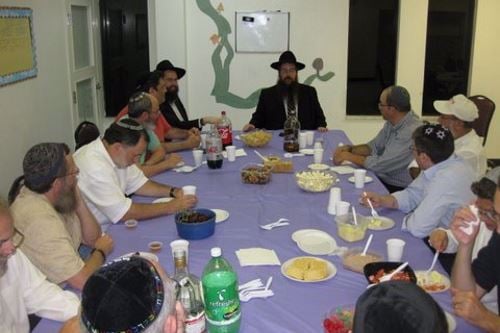
In Advance
A farbrengen is not a fancy event; no need to dress up. However, guys should make sure to cover their heads, and women should dress in a modest top and skirt or dress. You are not expected to bring a gift, so just come with an open mind and heart.
What Can I Expect to See?
You’ll almost always find people arrayed around a table (or tables) with light refreshments. In days gone by, traditional farbrengen fare would have been onion salad, herring and other Eastern European staples. Today, you’re likely to also see hummus, chips and other snack foods. There will probably also be some vodka or other fine spirits.
Farbrengens tend to be gender-specific, so guys will farbreng with guys, and gals will farbreng with gals.

Can I Help Myself?
First thing, find a seat. There is no arranged seating, so just settle into an open spot.
The food on the table is not there for show, so feel free to help yourself.
The alcohol, when it is served, is a bit more complicated. Here is what you need to know: In chassidic culture, pouring yourself a drink is considered to be uncouth. Rather, someone else should pour for you. Also, drink in moderation; you don’t want to get to the point where you would act foolishly. Lastly, drink only when toasting l’chaim. You’ll notice that from time to time everyone lifts their glasses for a group l’chaim. That is a good time to do the same.

So What Are We Going to Do?
There is no set procedure, but here are the basic elements that go into a good farbrengen:
- Chassidic melodies. Ranging from upbeat, thumpin’-on-the-table tunes that express the joy of Jewish life to the meandering, soulful songs that tell of the deep-seated desire for oneness with the divine, these melodies, called niggunim, have been passed down for generations and form the backdrop for a good farbrengen. Often, one niggun follows another. Musical instruments are very rarely present. Even if you do not know the tune or the words, you can still hum or sing along to the best of your ability. Everyone is invited to experience the farbrengen firsthand, so dive in!
- Discussion. Some farbrengens are open discussions amongst the participants, where everyone shares whatever pertinent thoughts, feelings or stories he or she wishes to contribute. Other times there is a leader, often a senior chassid or respected rabbi. If there is a leader, take your cues from those around you as to whether it’s appropriate to bring up a new subject or share your feelings on whatever is being discussed.
The discussions at a farbrengen may be more frank than what you’d normally expect, but all in a spirit of genuine concern and unity.

- Torah teachings. Sometimes, especially in the case of a birthday farbrengen, someone will review a chassidic discourse. There is a specific procedure for how this is done. The discourse is preceded by a slow, moving niggun, and followed by a fast-paced, joyous one. The actual discourse, called a maamar, is said sitting down. The person will typically cast his eyes downward, or even close them, and say the maamar (by heart) in a singsong voice. The maamar is traditionally said in Yiddish, but some people will recite it in Hebrew or English. Even if you understand the language of delivery, do not be dismayed if you do not fully grasp the subject being given over. It’s esoteric stuff that presupposes a lot of prior knowledge.
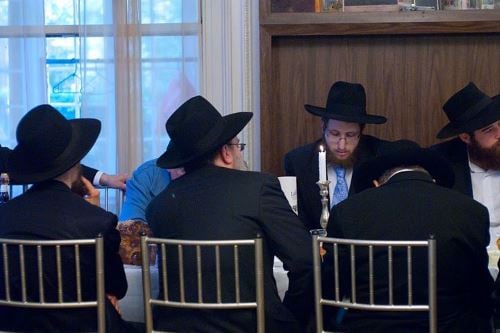
- Inspiration. A farbrengen is a personal experience, where each person comes close to those around him and to his own inner self. Allow the tunes to wash over you, the words to penetrate you, and the heartwarming camaraderie to envelop you.
- Good resolutions. A good farbrengen is one whose effects are evident in the days and weeks that follow. People will often take advantage of the inspiration of the moment and channel it into a positive life change called a hachlatah (Hebrew for “resolution”). A hachlatah may be to add in Torah study, prayer or mitzvah observance, or even to improve an interpersonal relationship. A good hachlatah is one that you can actually follow through with.
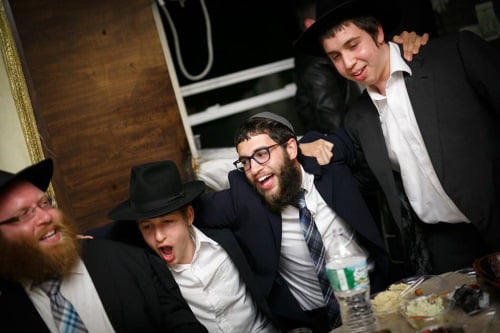
Chances are you’ve been told when to come, but you haven’t been told when the farbrengen will end. That’s because there is no official time to end a farbrengen. As long as there’s a warm atmosphere and a flow of inspiration, who’d want to leave? That said, if you feel you need to go, just wait for a lull in the conversation and head on home. Hopefully, the inspiration will come along with you, and the farbrengen will never truly end.
Postscript:
No article on farbrengens is complete without mentioning the legendary farbrengens conducted by the Rebbe—Rabbi Menachem M. Schneerson, of righteous memory. Like the farbrengens we discussed above, the Rebbe’s gathering included rousing chassidic melodies, words of Torah, and heartfelt discussion of issues of the day.

However, the Rebbe’s farbrengens were unique in many ways.
With few exceptions, the only one to speak was the Rebbe; they were the prime medium of teaching the public his revolutionary Torah insights and practical lessons for daily life.
The Rebbe’s talks often took a very scholarly bent, devoting hours to the most minute details of the Talmud and the teachings of Rashi, Maimonides and others. Each of the lengthy and scholarly talks would be delivered without any notes or teleprompters. A highlight of each farbrengen was perhaps the new maamar the Rebbe would usually deliver, expounding on Kabbalistic and chassidic teachings. During short intervals between the talks, the crowd would sing chassidic melodies, which the Rebbe would lead himself on occasion. Of course, no farbrengen was complete without a call for action, during which the Rebbe would urge his listeners to greater commitment to a Torah lifestyle.
There was little in the way of food or drink, save a symbolic platter of cake, bags of challah rolls or hard kichel, and small shot glasses of wine. During the singing breaks, participants would lift their glasses toward the Rebbe, and he would acknowledge each toast with a nod of his head.
Participants described the farbrengens as an unparalleled experience, a transcendental journey into an otherworldly plane where the world is viewed from inside out through the lens of Torah and Jewish tradition.
Attended by thousands, the Rebbe’s farbrengens could often last for many, many hours. When not held on Shabbat, the Rebbe’s words were shared via simultaneous translation, telephone hookup and syndicated cable coverage. The transcripts of these farbrengens have filled hundreds(!) of books, and—together with his many thousands of letters—form the base of the Rebbe’s written legacy.
With the exception of Shabbat, when the handling of money is forbidden, the Rebbe would usually conclude each farbrengen by distributing dollar bills to the participants to be given to a charity of their choice.
You can see videos of many of the Rebbe’s farbrengens here.
Did you find this informative? This is part of a series of “What to Expect” articles that offer visitors a basic understanding of Jewish rituals and traditions.

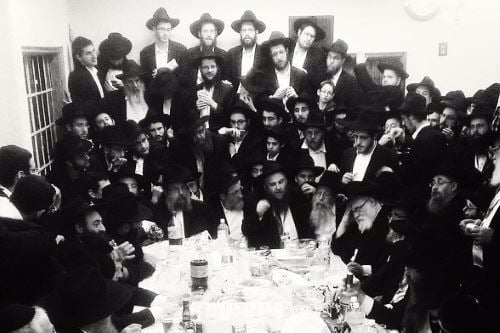


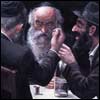

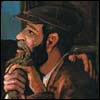


Join the Discussion